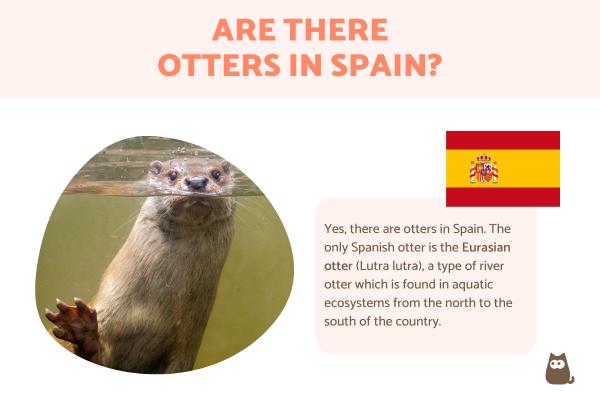Are There Otters in Spain?


Otters are animals with an almost global population distribution, only lacking a presence in Australia and Antarctica. Despite such a wide habitat range, threats to their homes and other factors have changed population numbers dramatically. In particular, European otter populations were once much more widespread than they are currently. Populations had been seriously in decline and even completely disappeared in some regions. Thankfully, conservation efforts have resulted in some areas seeing otters return to the landscape. In Spain, Eurasian otters (Lutra lutra) have returned to their aquatic landscapes after a period of severe decline.
At AnimalWised, we ask are there otters in Spain? We look at where to find otters in Spain, the species of Spanish otter and what threats they face in their semi-aquatic ecosystems.
Are there otters in Spain or not?
Yes, there are otters in Spain. Otters are semi-aquatic mammals found in rivers, lakes, wetlands and coastal areas throughout the country. After suffering a significant decline in the 20th century due to water pollution, hunting and habitat destruction, the otter has experienced a remarkable recovery in recent decades. This is thanks to improved water quality, legal protection and the hard work of conservation efforts.
Today, otters are present in most river basins in Spain, although their density varies depending on the region and the characteristics of the available habitat. They are found in both mountainous and lower areas, as well as in some coastal regions. In these areas, they have adapted to life in estuaries and marine areas close to the coast.
Find out about whether another mammal species is found in this region with our article asking are there skunks in Spain?
What types otters live in Spain?
There is only one species of otter found in the wild in Spain, the Eurasian otter (Lutra lutra). Also known as the European otter, common otter or Old World otter, this species is widely distributed in Europe and Asia. It is the only native otter in the Iberian Peninsula which includes Spain.
The Eurasian otter is a medium-sized semi-aquatic mammal with an elongated body, short legs and a long tail that has a cylindrical shape. Its fur is dense and adapted to water, meaning it protects their soft tissues from dampness and cold. Their coloration varies from dark to light brown. The European otter is well adapted to aquatic life, with webbed feet for swimming and a streamlined body that facilitates its movement in the water. They can also move very swiftly across terrestrial areas.
Discover all the different types of otters with our related wildlife guide.

Where are otters found in Spain?
The Eurasian or European otter is found in areas near a wide variety of water bodies in Spain. These include rivers, lakes, reservoirs and wetlands. The presence of otters ranges from the north to the south of the country:
- Northern Spain: otters are found in regions such as Galicia, which has several rivers and wetlands that provide ideal habitats for this mammal. Areas such as the Miño River and the Ulla River are known to have otter populations. In Asturias, the rivers and reservoirs of this region are common habitats for otters. These include the Sella River and the Tanes Reservoir. In Cantabria, rivers such as the Deva and the Pas are home to otter populations. The presence of these animals in the riverside areas is significant.
- Central and western Spain: in communities such as Castile and Leon, the otter is present in the Duero River and the Riaño reservoir. The aquatic habitats in this region are suitable for the species. In Extremadura, they are present in the Tajo River and the Orellana reservoir. To the west, they are found in Castilla-La Mancha, in rivers and wetlands in the region, including the Guadiana River and the Záncara River.
- Southern Spain: otters are found in Andalusia and in coastal areas close to the Atlantic and the Mediterranean. The areas included are the Guadalquivir River and the La Serena reservoir. They have also been sighted in estuaries and nearby coastal areas, such as the Guadalquivir River estuary and the coastal area of Huelva.
In these regions, otters prefer bodies of water with good quality and riparian vegetation, providing both shelter and food. They are also found in wetlands, which offer an environment rich in food resources and suitable breeding sites. In some regions, otters have adapted their life to estuaries and nearby coastal areas, where they can take advantage of a diversity of food resources.
Despite sometimes living in coastal areas, it is important to remember that there are no sea otters in Spain. The Eurasian otter is a type of river otter species, sometimes being known as the European river otter. This means they only spend their time in freshwater habitats.
You can learn more about the differences between river and marine otter species with our article which asks are otters dangerous?

How to protect otters in Spain
In Spain, the otter is included in the List of Wild Species under Special Protection Regime (LESRPE). Protecting them involves a comprehensive approach that addresses both the conservation of their habitat and the mitigation of the threats they face.
Here are several key strategies for the protection of otters in Spain:
- Restoring aquatic habitats: improving water quality in rivers, lakes and wetlands by reducing pollution and implementing sustainable water management policies. Restoring riparian vegetation is also crucial, as it provides shelter and food.
- Critical area protection: identify and protect key areas for otters, including breeding, feeding and transit sites. Establish protected areas where otters can live and breed without human disturbance.
- Maintaining connectivity: ensuring connectivity between aquatic habitats by creating ecological corridors that allow otters to move freely and access different feeding and breeding areas.
- Pollution control: implement and enforce strict regulations to reduce pollution of water bodies. This includes proper management of industrial and agricultural waste, as well as prevention of chemical spills.
- Poaching prevention: strengthen surveillance and laws against poaching and illegal trade in otters and products derived from otters.
- Educational campaigns: conduct awareness campaigns to inform the public about the ecological importance of otters and how they can contribute to their protection. Include the information in educational programs and community activities.
- Population monitoring: conduct ongoing studies on the distribution, density and health of otter populations in Spain. Use monitoring techniques such as camera traps, scat analysis and genetic studies to obtain accurate data.
- Impact research: investigate how human activities, climate change and other threats affect otters. Use this information to adapt and improve conservation strategies.
- Legal protection: ensure that otters are protected under national and international legislation. Implement and enforce laws prohibiting poaching and habitat destruction.
- Promote responsible tourism: promote ecotourism and recreational activities that respect the habitat of otters, as well as benefiting local communities to best ensure the conservation of the species.
Implementing these strategies effectively can help ensure the long-term protection and conservation of otters in Spain, allowing them to continue to play their crucial ecological role in Spanish aquatic ecosystems.
You can learn more about the anatomy and behavior of this type of mustelid species with our article asking do otters have pouches?

If you want to read similar articles to Are There Otters in Spain?, we recommend you visit our Facts about the animal kingdom category.
- Barbosa, A. M., Real, R., Márquez, A. L., & Rendón, M. Á. (2001). Spatial, environmental and human influences on the distribution of otter (Lutra lutra) in the Spanish provinces. Diversity and distributions, 7(3), 137-144.
https://doi.org/10.1046/j.1472-4642.2001.00104.x - Barbosa, A. M., Real, R., Olivero, J., & Vargas, J. M. (2003). Otter (Lutra lutra) distribution modeling at two resolution scales suited to conservation planning in the Iberian Peninsula. Biological conservation, 114(3), 377-387.
https://doi.org/10.1016/S0006-3207(03)00066-1 - Lutra lutra. Ministry for the ecological transition and the demographic challenge (MITECO) https://www.miteco.gob.es/content/dam/miteco/es/biodiversidad/temas/inventarios-nacionales/ieet_mami_lutra_lutra_tcm30-99817.pdf







